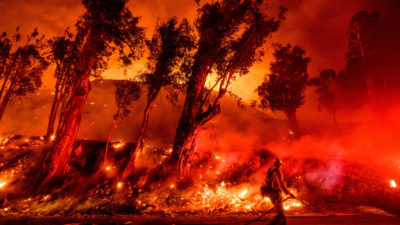 Animals eating plants might seem like an obvious way to suppress fire, and humans are already using the enormous appetites of goats, deer, and cows to reduce the fuel available for potential wildfires.
Animals eating plants might seem like an obvious way to suppress fire, and humans are already using the enormous appetites of goats, deer, and cows to reduce the fuel available for potential wildfires. But other animals such as birds, termites, and elephants can also double as ecosystem engineers, naturally reducing or enhancing the chances, spread, or severity of wildfires as they go about their day-to-day grass-chewing, track-making, or nest-building. Researchers in Australia describe these and more surprising activities in a Review published March 5 in the journal Trends in Ecology & Evolution.
When it comes to grazing animals, it's important to consider which species of plants they are eating, and which are left behind. "A lot of the things that make a plant good to eat are the things that make it hard to burn," says first author Claire Foster, terrestrial conservation biologist and research fellow at Australian National University. "When you take out all the nutritious, palatable plants, those left over tend to be drier and more flammable."
Studies have shown that removing large grazers like cattle or rhinoceros can increase wildfire temperature, as well as the size of individual fires and the total area burnt. But, it's important to note that these grazers are most effective as a fire management tool in grassy habitats like savanna; if domesticated grazers are used improperly, they can promote the growth of less tasty but more flammable plants. This can be a problem in alpine areas and in forests with mixed plant species, where selective feeding can increase the numbers of more fire-prone plants.
"It's very clear that when used strategically, and in the right ecosystems, mammals like goats and cattle can have strong fire-suppressive effects, but I've also seen many examples where they actually do the opposite and increase the risk of severe fires," Foster says.
But there may be other, less obvious animals that could also be used in fire defense. "Some of the animals we don't necessarily think of are the insects that, by feeding on leaves, stimulate the production of defensive chemicals in the plants, changing the flammability of their leaves," says Foster. Other kinds of insects likely play a strong role in removing dead leaves from the forest floor and, in some cases, can even provide shelter for other animals from fire.
"One of the most amazing examples is from savanna ecosystems with termites," she says. "They create massive structures where a huge variety of other animals choose to live. These 'nutrient islands' attract large herbivores that preferentially graze around the termite mounds, making them less likely to burn and creating a safety zone during moderate-severity bushfires."
Further, some animals can manage fire spread by changing the arrangement of plants or dead plant materials within their habitat. Similar to how you might rake your yard, malleefowl birds gather dead leaves into piles to incubate their eggs, helping clear the ground of leaf litter. Larger animals, like elephants, can trample down plants to form wide corridors between foliage. "Gaps in fuel can be really important for fire spread; animal tracks can act like mini roads, creating breaks that can cause extinguishment of the fire front," says Foster.
All together, Foster, senior author and University of Western Australia wildlife biologist Leonie Valentine, and their co-authors illustrate that direct plant consumption is only one of several mechanisms that can influence fire behavior. "Our approach was to encourage readers to think about the more subtle and indirect ways that animals might be altering fuels and to help avoid risky assumptions when we plan strategies to reduce the risk of fire outbreaks," Foster says. "We also encourage readers to consider ways that changes in wildlife populations -- and not just grazers -- might influence patterns of fire."
Next, Foster and her lab are investigating the relationship between forest insects and rates of leaf-litter breakdown within ecosystems as well as the effects of kangaroos and wallabies on the behavior of fire in Australian forests.
This project was funded by an ARC Linkage Project, in collaboration with Parks Australia and the Department of Defence, as well as the Australian Government's National Environmental Science Program, through the Threatened Species Recovery Hub.









My name is Mrs Aisha Usman, am a Citizen Of Singapore. Have you been looking for a loan? Do you need an urgent personal loan or business loan?contact Dr. Mark Thomas FOIRM Ronnie Finance Ltd he help me with a loan of $85,000 some days ago after been scammed of $4,800 from a woman claiming to been a loan lender but i thank God today that i got my loan worth $85,000.Feel free to contact the company for a genuine financial service. Email:markthomasfinanceltd@gmail.com
ReplyDeleteWhats-App no +919667837169
Dr. Mark Thomas
LOAN APPLICATION DETAILS
Name:…………
Address…………
Loan Amount:……
Loan duration…
Monthly income…………
Nationality……
Country………
Occupation......
State…………
Zip/Code………
Gender…………
Age…………
Marital Status……………
Telephone………………
FORM Ronnie Finance Ltd
Dr. Mark Thomas